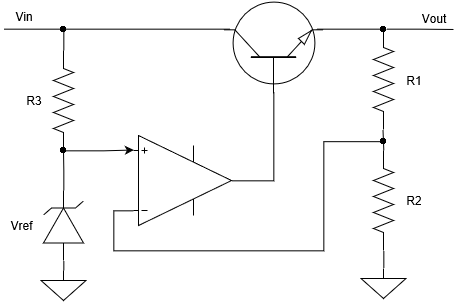There are two main types of DC:DC power converters: Linear Regulators, and Switching Regulators. Linear regulators are relatively simple but are typically much less efficient than the more complex switching regulators. For either type of DC power converter, the inefficiency of power conversion is dissipated in the form of heat.

A linear regulator produces an output voltage derived from the input voltage through a transistor that is controlled by feedback. The output voltage is divided down and compared against a reference voltage with a comparator that drives the base of the transistor. Feedback is connected to the negative input of the comparator, because in that configuration the base of the transistor gets turned on when output voltage goes down making the transistor turn on more and reduce resistance between Vin and Vout.
In high-level terms a linear regulator is like a controller resistor. The current flowing in is essentially the same as the current flowing out, since the control circuitry draws a trivial amount of current compared to the current drawn by the power load. Like with all electronic components the power dissipated by the linear regulator is the voltage across it times the current through it. Dissipated power is also equal to the input power minus the output power by the Law of Conservation of Energy. The power dissipated is the voltage drop Vin – Vout multiplied by the current Iout.
IOUT = IIN
PLOSS = (VIN – VOUT) * IOUT
PLOSS = PIN – POUT
Power dissipation can quickly get out of hand. Converting from a 5V rail to a 3.3V rail to supply one Amp or 3.3W of power would dissipate (5 – 3.3) / 1 = 1.7W. That’s half of your output power, 50% inefficiency! And, sufficiently cooling 1.7W is a non-trivial endeavor. As a rule of thumb, cooling up to 1W often can be done by just spreading heat to the ground planes, cooling 1W – 3W may start needing a heatsink on the component, beyond that you may need think about a fan or special heatsink.
The inefficiency is proportional to the voltage drop from input to output, so minimizing this value minimizes the power dissipation if the load current is fixed. In the last decade linear regulator makers have produced Low Drop-Out (LDO) regulators that function down to 200 mV or even less drop between input and output.
In summary, linear regulators are used when the difference between input and output voltage is small or the load current requirement is small. They work great for applications where they will dissipate 1W or less. Beyond that or if you have strict efficiency requirements such as for a battery powered device, start thinking about using a switching regulator.
Helpful Videos
This training module from Texas Instruments is excellent: https://training.ti.com/linear-regulator-fundamentals-types-linear-regulators
Here is another training module from TI that focuses on thermal considerations for linear regulators.
